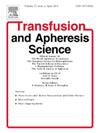Considerations on the number of plasma donations per donor per year: Pro
IF 1.2
4区 医学
Q4 HEMATOLOGY
引用次数: 0
Abstract
Background and objectives
Although plasmapheresis is generally well tolerated, there is a matter of debate about the number of yearly plasma donations. While some countries follow a very conservative approach with a low number of yearly donations others allow for up to 104 plasma donations per year. This article summarises side effects and possible long-term effects of frequent plasmapheresis analysing the current literature data.
Study design and methods
Donor-related and machine-related adverse events were identified. Donor-related adverse events were subdivided into actual and possible long-term health effects.
Results
Vasovagal reactions and venepuncture-related problems were the most often actual side effects. Reported issues of long-term adverse events were iron deficiency, loss of protein/immunoglobulin G (IgG), and the occurrence of malignancies. There are contradictory reports in the literature for the occurrence of iron deficiency and malignancies as well as the impact of immunoglobulin loss with respect to infections.
Conclusions
Evidence-based data about the impact of frequent plasmapheresis on donor health are poor. High-quality studies on risks and outcome of frequent plasmaphereses are needed to ensure donor health.
每位献血者每年献血血浆数量的考虑因素:Pro
背景与目的虽然血浆置换术的耐受性良好,但每年的血浆捐献数量仍存在争议。一些国家采取非常保守的做法,每年献血的数量很少,而另一些国家则允许每年捐献多达104次血浆。本文通过对现有文献资料的分析,总结了频繁血浆置换的副作用和可能的长期影响。研究设计和方法确定了供体相关和机器相关的不良事件。供体相关不良事件被细分为实际的和可能的长期健康影响。结果血管迷走神经反应和静脉穿刺相关问题是最常见的实际副作用。报道的长期不良事件的问题是缺铁,蛋白质/免疫球蛋白G (IgG)的损失和恶性肿瘤的发生。关于缺铁和恶性肿瘤的发生,以及免疫球蛋白丢失对感染的影响,文献中有相互矛盾的报道。结论频繁血浆置换对献血者健康影响的循证数据不足。为确保供体健康,需要对频繁的血浆分裂的风险和结果进行高质量的研究。
本文章由计算机程序翻译,如有差异,请以英文原文为准。
求助全文
约1分钟内获得全文
求助全文
来源期刊
CiteScore
3.60
自引率
5.30%
发文量
181
审稿时长
42 days
期刊介绍:
Transfusion and Apheresis Science brings comprehensive and up-to-date information to physicians and health care professionals involved in the rapidly changing fields of transfusion medicine, hemostasis and apheresis. The journal presents original articles relating to scientific and clinical studies in the areas of immunohematology, transfusion practice, bleeding and thrombotic disorders and both therapeutic and donor apheresis including hematopoietic stem cells. Topics covered include the collection and processing of blood, compatibility testing and guidelines for the use of blood products, as well as screening for and transmission of blood-borne diseases. All areas of apheresis - therapeutic and collection - are also addressed. We would like to specifically encourage allied health professionals in this area to submit manuscripts that relate to improved patient and donor care, technical aspects and educational issues.
Transfusion and Apheresis Science features a "Theme" section which includes, in each issue, a group of papers designed to review a specific topic of current importance in transfusion and hemostasis for the discussion of topical issues specific to apheresis and focuses on the operators'' viewpoint. Another section is "What''s Happening" which provides informal reporting of activities in the field. In addition, brief case reports and Letters to the Editor, as well as reviews of meetings and events of general interest, and a listing of recent patents make the journal a complete source of information for practitioners of transfusion, hemostasis and apheresis science. Immediate dissemination of important information is ensured by the commitment of Transfusion and Apheresis Science to rapid publication of both symposia and submitted papers.

 求助内容:
求助内容: 应助结果提醒方式:
应助结果提醒方式:


